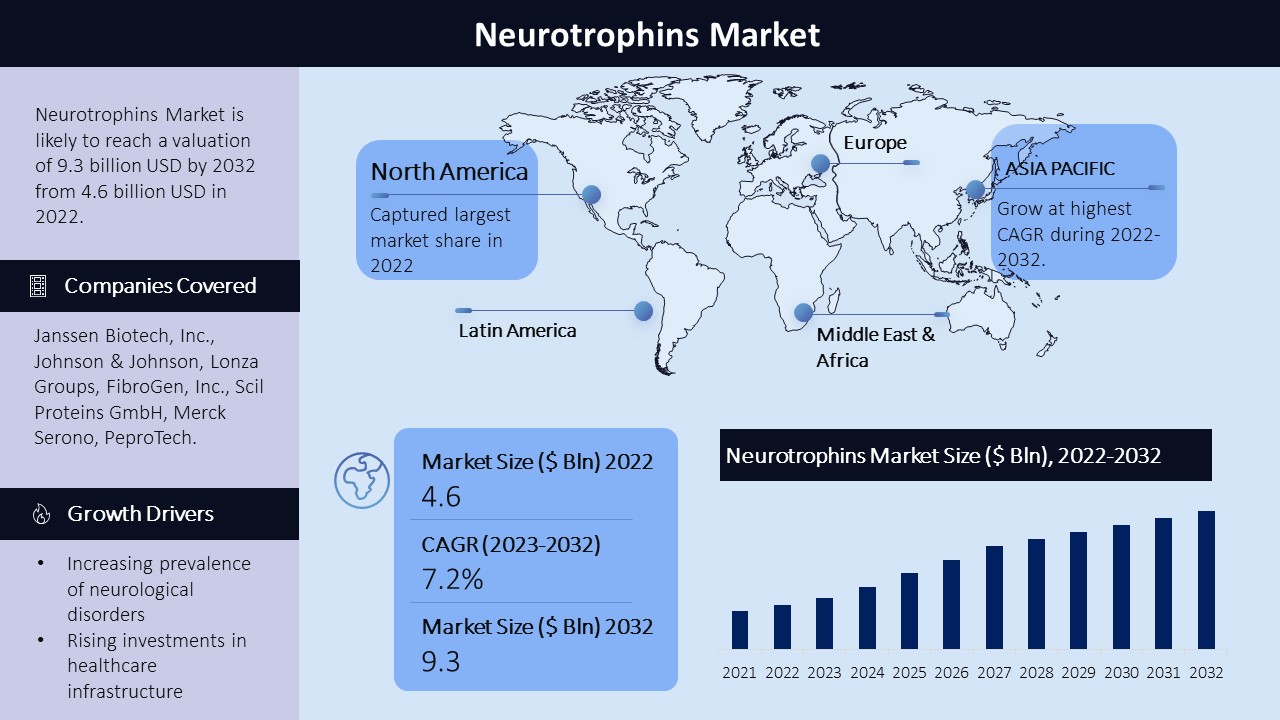Neurotrophins Market Analysis by product type); application : Anticipated Growth and Development (2022-2032)
Neurotrophins market by product type (nerve growth factor, brain-derived neurotrophic factor, neurotrophin-3, dehydroepiandrosterone sulfate); application (Alzheimer’s disease, amyotrophic lateral sclerosis, Parkinson’s disease, other); end-user (hospitals, diagnostic centers, others) and geographic regions (North America, Europe, Asia pacific, Latin America, Middle East, and Africa): industry trends and global forecasts, 2023-2032
Neurotrophins Market Size and Overview:
The neurotrophins market has witnessed consistent growth, achieving a CAGR of 7.2% from 2023 to 2032 and reaching a market value of $9.3 billion in 2032. This growth is driven by the increasing prevalence of neurological disorders and the growing demand for advanced treatment options. Neurotrophins, a class of proteins essential for neuronal growth and maintenance, are crucial in addressing various neurological conditions. The market is characterized by intense competition, with prominent players focusing on research and development efforts to introduce innovative neurotrophin therapies. Their aim is to meet the evolving needs of healthcare providers and patients, ensuring better outcomes and advancements in the field of neurotrophin-based treatments.
Market Segmentation:
Product Type:
- Nerve Growth Factor
- Brain-derived neurotrophic factor
- Neurotrophin-3
- Dehydroepiandrosterone sulfate
Applications:
- Alzheimer's Disease
- Amyotrophic Lateral Sclerosis
- Parkinson's Disease
- Others
End-Users:
- Hospitals
- Diagnostic Centers
- Others
Geographic Regions:
- North America
- Europe
- Asia Pacific
- Latin America
- Middle East and Africa
Hospitals: Among the different end-users, hospitals represent the largest segment in the neurotrophins market. This is primarily due to the growing demand for effective treatments for neurological disorders and the increasing number of hospitals globally. Neurotrophins play a vital role in the diagnosis and treatment of various neurological conditions, making them essential for hospitals providing healthcare services to patients with such disorders.
Regional Analysis:
The regional analysis of the Neurotrophins market unveils distinct trends and dynamics across different parts of the world. Beginning with North America, this region represents one of the largest and most developed markets for Neurotrophins, primarily driven by the United States. In Europe, countries such as Germany, France, and the United Kingdom hold substantial market shares in the Neurotrophins industry. These countries exhibit a strong focus on healthcare innovation and have well-established pharmaceutical sectors, contributing to the growth of the market. The Asia Pacific region presents immense growth potential in the Neurotrophins market. Rapid urbanization, increasing healthcare expenditure, and a rising geriatric population contribute to the expansion of the market in this region. Countries like China, Japan, and India are witnessing a surge in demand for Neurotrophins, driven by the growing prevalence of neurological disorders and increasing awareness of the benefits of these therapies. Latin America showcases steady growth in the Neurotrophins market, fueled by improving healthcare infrastructure, a rising middle class, and an increasing focus on neurological research. the Middle East and Africa region demonstrates a developing market for Neurotrophins, driven by urban development initiatives, a growing focus on healthcare, and an increasing emphasis on neurological disorders.

Growth Drivers:
The neurotrophin market is driven by several key factors that contribute to its growth and development. Firstly, the increasing prevalence of neurological disorders worldwide is a significant driver. Neurological disorders, such as Alzheimer's disease, Parkinson's disease, and amyotrophic lateral sclerosis, amongst others, are on the upsurge due to numerous aspects like aging populations and changing lifestyles. This increasing disease burden necessitates effective treatments, leading to a growing demand for neurotrophins.
Additionally, the advancements in medical research and understanding of neurotrophins' role in neuroprotection and neuroregeneration have spurred market growth. The expanding knowledge about neurotrophins' potential therapeutic applications in addressing various neurological conditions creates new opportunities for market players.
Moreover, the rising investments in healthcare infrastructure and the increasing focus on neurological disorder management drive market growth. Governments and healthcare organizations across different regions are prioritizing the improvement of neurological healthcare services, leading to increased accessibility and availability of neurotrophin-based treatments.
Furthermore, the growing demand for personalized medicine and precision therapies is contributing to the expansion of the neurotrophin market. As the field of neuroscience advances, there is a greater understanding of individual variations in neurotrophin requirements and responses, leading to the development of targeted therapies tailored to specific patients.
Challenges:
Despite the promising growth prospects, the neurotrophins market faces certain challenges. One significant challenge is the high cost associated with neurotrophin-based treatments. The production and development of neurotrophins involve complex processes, which can result in high manufacturing costs. This can limit access to these treatments,
Key Companies:
Prominent players in the Neurotrophins market encompass a range of leading companies that contribute to the advancement of this industry. These companies include Janssen Biotech, Inc., Johnson & Johnson, Lonza Groups, FibroGen, Inc., Scil Proteins GmbH, Merck Serono, PeproTech, Inc., AbbVie, Alcon, Allergan, AstraZeneca, BioMarin Pharmaceutical, Bristol-Myers Squibb, Eli Lilly and Company, GlaxoSmithKline, and GE Healthcare, among other players.
To enhance their market share and stay competitive, these companies employ strategic approaches such as product innovation, strategic partnerships, and mergers and acquisitions. By investing in research and development, they continuously strive to improve existing therapies and develop new ones. Collaborations with academic institutions and other industry players further contribute to their innovative efforts.
For instance, Janssen Biotech, Inc., a key player in the neurotrophins market, has a strong focus on advancing neurotrophin-based therapies for neurological disorders. They have successfully brought several innovative products to the market, improving patient outcomes and quality of life.

Need Customized Report for Your Business ?
Utilize the Power of Customized Research Aligned with Your Business Goals
Request for Customized Report- Quick Contact -
- ISO Certified Logo -

















